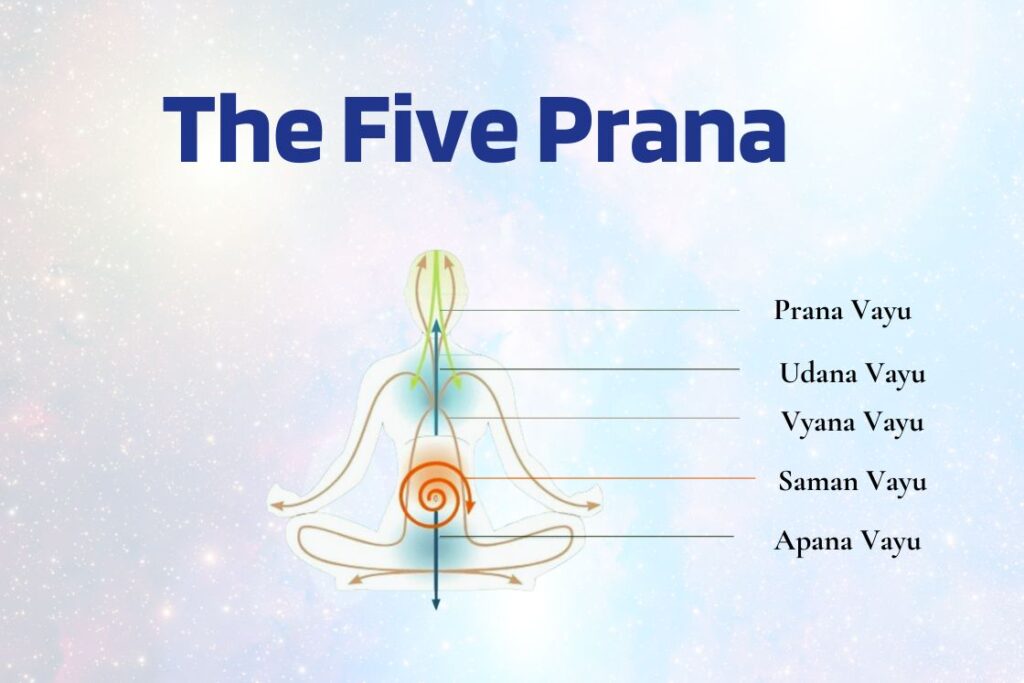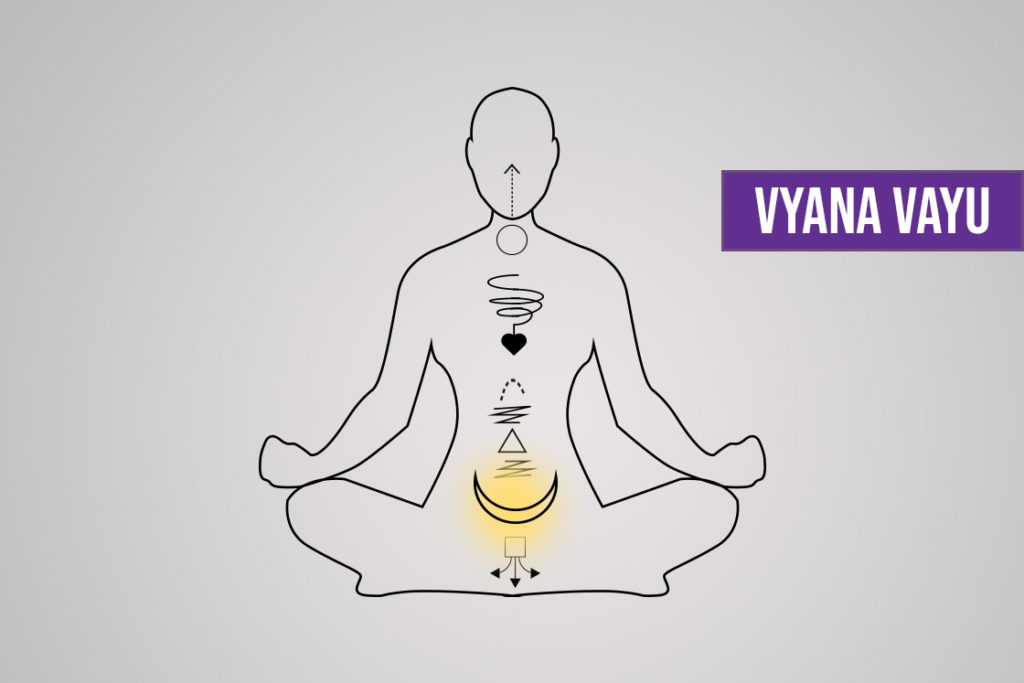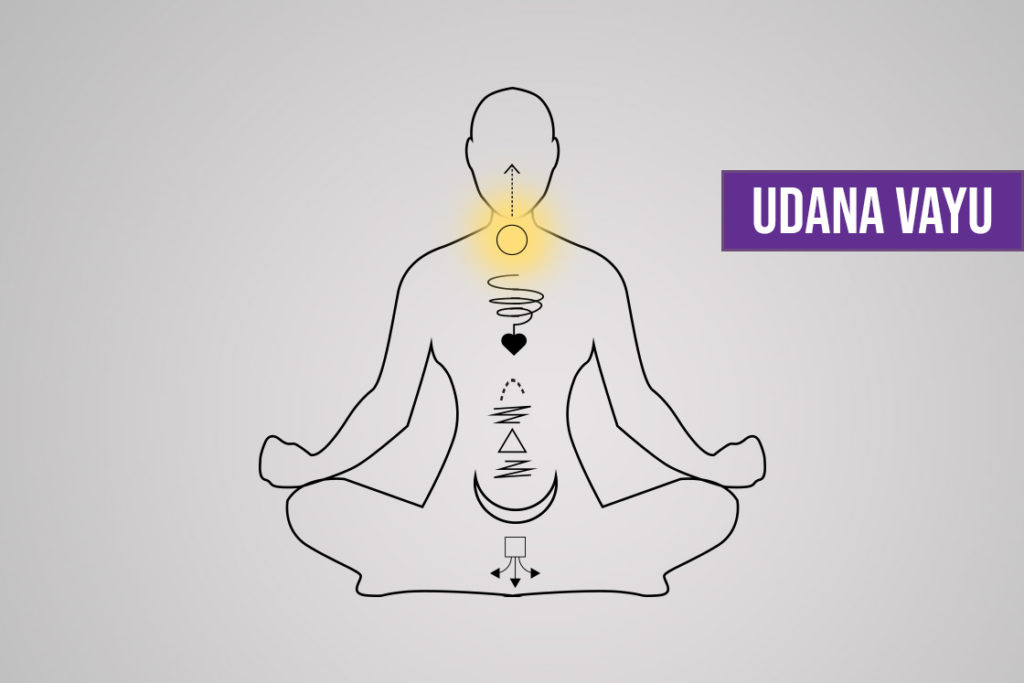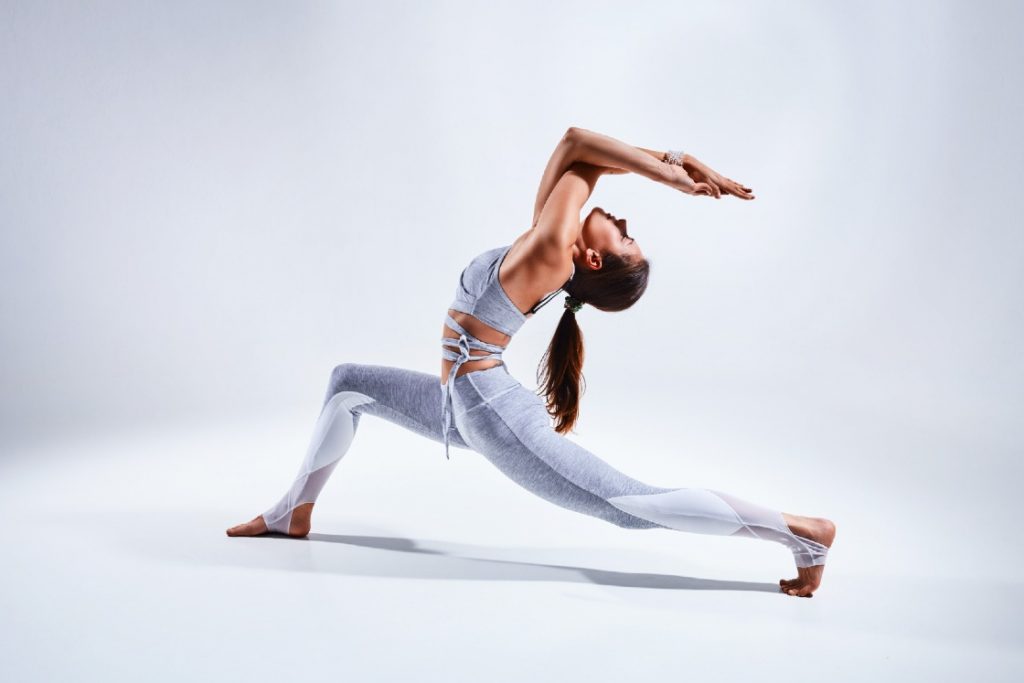- Vyana vayu
- Udana vayu
- Vyana Functions
- Udana Functions
- Imbalanced Vyana
- Imbalanced Udana
- Balancing vayus

The last two subtypes of Prana are Vyana Vayu and Udana Vayu. While Vyana Vayu is responsible for circulation, Udana Vayu governs free expression and growth—both mental and physical.
Each of these Vayus, in one way or another, supports the other three Vayus: Prana, Samana, and Apana Vayu. Prana Vayu is the most fundamental of all, serving as the vital energy force. Apana Vayu is responsible for eliminating toxins from the body and mind, while Samana Vayu unites the energies of Prana and Apana at the navel center.
In the series of 5 Prana vayus this article, we will see how vyana and udana vayu serve an important purpose.
Vyana Vayu

The Sanskrit word Vyana means “outward moving.” This Vayu moves from the center of the body to other parts, including the brain. It is associated with the element of water and shares its characteristics.
Just like the fluidity of water, Vyana Vayu does not have a specific location. In its true sense, it is all-pervading and represents the omnipresent air.
The connection to the entire body is established through the various, specifically 72,000, energy channels or Nadis. Thus, the movement of the prana shakti is made possible through the vyana vayu.
Vyana Vayu, as already stated above, is responsible for circulation. The term circulation refers to the circulation of blood and nutrients done by the multiple nerves, signals and impulses done by the nervous system, and movement of various fluids through the lymphatic system.
All of this makes it possible for the muscles and joints to move without hitch and encourages the flow of thoughts and emotions in the brain.
The chakra associated with vyana vayu is the Sacral Chakra or the Svadisthana. It maintains the creative flow of an individual, emotional balance, and feelings of desire.
Udana Vayu

The udana vayu is the “ascending air” or the “air which carries upwards”. The upward movement holds us up, makes us stand straight. It supports the movement of prana from the lower to the upper chakras. Moving through the chakras, udana also helps in awakening the kundalini shakti.
Udana vayu location is said to be between the heart and the head, thus it also signifies the movement from the lower plane to the higher consciousness.
The throat or the Vishuddha Chakra is the seat of expression for the udana vayu. Hence it also governs the ability to freely express your feeling, opinions, thoughts, and emotions. Additionally, it stimulates the Ajna chakra which makes us determined, confident and improves feelings of enthusiasm and willpower. These characteristics combined help us grow physically, mentally, and spiritually.
The element of space or ether is connected with the udana vayu, which makes sense as the movement of the vayu goes towards the head. The chakras in the head are responsible for calmness, stillness, connection with spirituality and cosmos, and inner peace.
Its physical connection with the thyroid and parathyroid glands maintains the healthy metabolic and nervous system functioning.
Functions of Vyana Vayu
Circulation is the major function of the vyana vayu. It helps in circulating the nutrients, water, and blood to the various parts of the body. This circulation is supported by the contraction and expansion of the heart.
The pumping of the heart is also governed by the vyana vayu. The involuntary motions help cleanse the blood and supply fresh blood to the body. It helps each organ to work at its optimum level.
Moreover, the movement of the joints and muscles is also one of the key functions of the vyana vayu. Along with the prana vayu, the vyana vayu is responsible for walking, running, downward and upward movement of limbs, yawning, blinking of eyelids, or any movement in general.
The flexion and extension of the spine also come within the purview of the vyana vayu.
Since metabolism is also being controlled by the vyana vayu, the process of elimination of toxins from the body becomes another important function. However, in this, the samana and apana vayu provide their support. The segregation of digestible and indigestible food, production of sweat, and elimination of waste (through urine or defecation) is made possible through vyana vayu.
Functions of Udana Vayu
The udana vayu works in conjunction and coordination with the other vayus to bring out the best your mind and body have to offer.
If we look at udana vayu’s function as stand-alone, it aids in speech, articulation, pronunciation, modulation of voice, and ability to sing. It stimulates the throat and nose to produce the words. With a little help from prana and samana vayu, it creates the energy to speak. It also stimulates the soul, mind, and intellect to produce words.
The energy, strength, endurance to perform any activity and immunity are the result of the udana vayu working the prana and the vyana vayu. This energy is given by the healthy functioning of the heart, which provides nutrients and blood, and lungs, which provide oxygen to the blood.
The udana vayu also aligns itself with the kapha and pitta dosha to provide immunity and energy.
On the mental front, memory, processing, production of information, and general functioning of the mind are also done by the udana vayu. It is the prana vayu that governs most of the mind’s activities and functioning, however, the oxygen and blood supply is fulfilled by the udana vayu.
Signs of imbalances in Vyana Vayu
As vyana vayu is present throughout the body, any disturbance in any part of the body can be a cause of a vitiation. Something as simple as fever is also one of the symptoms of an unbalanced vyana vayu.
Below are some common signs of a disturbed vyana vayu
- Poor circulation, disturbed nerve stimulation
- Loss of sense of taste
- Skin disorders, blocked skin pores
- Lack of coordination, tremors, loss of mobility
- Anorexia, heart attack due to blocked arteries
- Malnutrition
- Inability to reach out to people
- Erratic and cluttered mind
- Feelings of separation and alienation
- Low energy, compromised immune system
Signs of imbalances in Udana Vayu
Most symptoms will relate to physical issues with the throat and mouth. And since it is an upward moving vayu, issues related to mental health will also arise. Many such signs can be seen in the below list:
- Speech difficulties, lack of self-expression
- Diseases of the throat, stuttering, voice hoarseness
- Shortness of breath, asthma, emphysema
- Uncoordinated movement, loss of balance
- Depression, negative mindset
- Poor memory, inability to think clearly
- Lack of creativity, direction, goals, willpower, enthusiasm
- Inefficiency in physical and mental work
- Forgetfulness
- Lack of self-esteem
Balancing Vyana and Udana Vayus

Being aware of the issues and quickly identifying the source will aid in balancing the vayus right away. The other way is to follow a lifestyle that promotes the healthy functioning of the vyana and udana vayu. You will be mitigating the risk of contracting diseases or ailments in the future.
And there is no better holistic approach than practising yoga, pranayama and mudra. These practices not only focus on the physical body but also on all the nitty-gritty that we may not be aware of.
1. Yoga Asanas
Vyana Vayu
Due to the nature of vyana vayu, practising vinyasa such as Sun Salutation will be extremely beneficial. It will promote the circulation of blood and oxygen throughout the body in a balanced manner.
Even standing and balancing poses, which involve the stimulation of the entire body will bring awareness to the vyana vayu. All Warrior Series Poses, Triangle Pose, Eagle Pose, Half-Moon Pose and Chair Pose are some of the poses that you can practice.
Udana Vayu
For udana vayu, focus on practicing yoga asanas that incorporate the opening of the neck and shoulder and also focus on the placement of the head. Shoulder Stand, Head Stand, Plough Pose, Fish Pose, Bridge Pose, Lion Pose, Legs-up-the-wall Pose, etc can be practiced to promote and balance the flow of udana vayu.
2. Pranayama
Vyana Vayu
Anulom-Vilom, Nadi Shodhana (Alternate Nostril Breathing) and Kumbhaka (Breath Retention) are two extremely beneficial pranayamas that can help in balancing the vyana vayu. As it will not only strengthen the lungs but also stimulate brain functions.
Udana Vayu
Simhasana (Lions’s Breath), Ujjayi Pranayama (Victorious Breath) and Bhramari Pranayama (Bumblebee Breath) will stimulate the nose, ears, throat, and mouth. In these pranayamas, you make a distinct sound which will stimulate the physical throat. On the energetic plane, it will activate the third eye and the throat chakra as well.
3. Mudra
The mudra for each of these vayus should be practiced for 15 minutes 3 times a day or for 45 minutes at a stretch. As soon as the signs of imbalance are alleviated, you should stop practicing the mudra as it may lead to an adverse effect in any of the 5 elements.
Vyana Vayu
Imbalance symptoms can also occur due to stagnation or an overactive vyana vayu. To balance it, you can practice the Vyana Mudra while performing meditation. To practice this mudra, bring the tips of the index and middle finger to touch the tip of the thumb as if you were pinching something.
This mudra helps in blood circulation, increases enthusiasm, reduces fatigue, and improves heart health. It also establishes a connection with the sacral chakra.
Udana Vayu
For the udana vayu, practicing Udana Mudra will prove to be effective. This hast mudra is practiced by joining the tips of the index, middle and ring finger with the tip of the thumb. Regular practice of the mudra will boost the flow in the chest cavity, throat and brain, improve vocal cords, enhance memory, creativity, and alleviate respiratory problems.
While meditating, you can engage the Jalandhara Bandha or the throat lock. And chanting a mantra, such as bija mantra of throat chakra HAM or OM, will enhance the power of the mudra and stimulate the third eye and the throat chakra.
Conclusion
By bringing awareness to the vayus, you are reflecting on the needs of the mind and body on a deeper level. Once you gain an understanding of the working nuances of each of the vayus, you will find all the answers to your problems within you.
Once you build a connection with each of the vayus, with the help of yoga, pranayama, and meditation, it will be easier to control your mind and body.





Pourriez vous m”indiquer la pratique correcte des 3 Bandhas ( vérouillages ) ?
Joindre Prana à Apana, c”est le but ultime du yoga me disait mon défunt proffesseur de Hatha-Yoga.
Et pour ce faire j’aurais besoin de parefaire ma connaissance de l’utilisatikon des 3 Bandhas.
Vous en remerciant par avance.
Hari Om.
Michel MARZEC